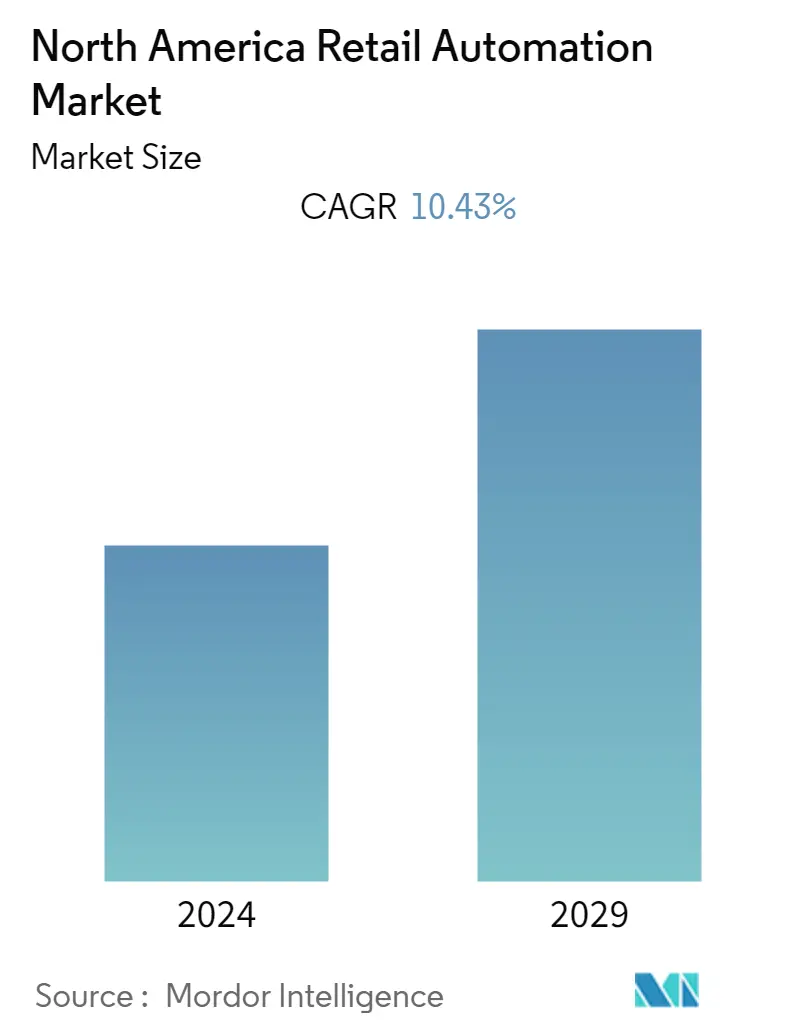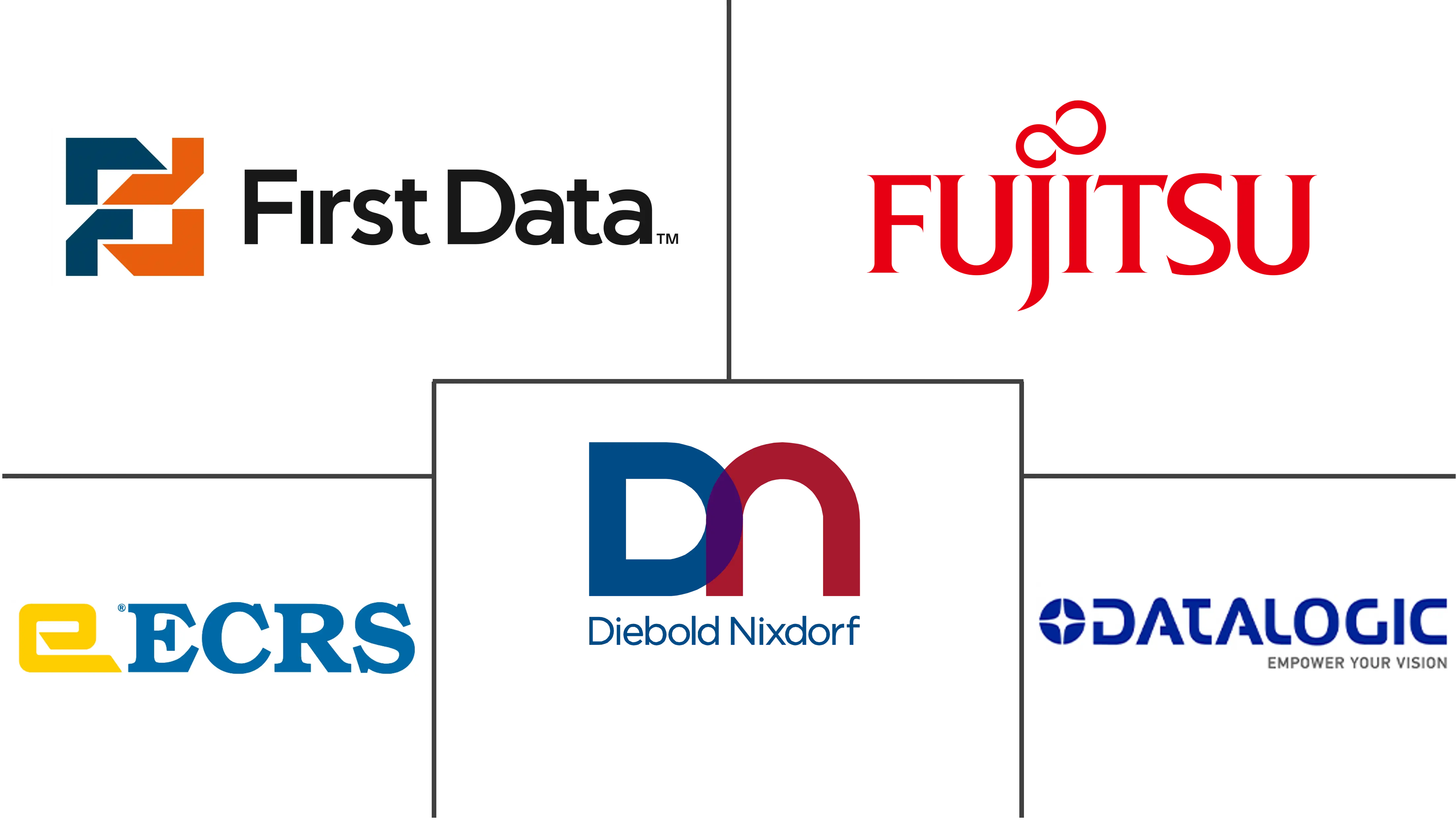Market Size of North America Retail Automation Industry

| Study Period | 2019 - 2029 |
| Base Year For Estimation | 2023 |
| Forecast Data Period | 2024 - 2029 |
| Historical Data Period | 2019 - 2022 |
| CAGR (2024 - 2029) | 10.43 % |
| Market Concentration | Medium |
Major Players
*Disclaimer: Major Players sorted in no particular order |
North America Retail Automation Market Analysis
The North America Retail Automation Market is expected to register a CAGR of 10.43% during the forecast period(2024-2029).
- The COVID-19 pandemic created huge disruption in the retail industry and forced retailers to take various preventive measures, leading to the closure of several outlets. Owing to this, retailers and prominent brands across the globe faced short-term challenges across sustained revenues, health and safety, supply chain management, labor shortages, and pricing, to name a few.
- Automation is anticipated to play a major part in the growth of the retail industry; as the industry expands, automation helps retailers cut costs and drive efficiency. These solutions also enhance the customer experience and the efficiency of retail facility employees.
- Retailers are facing challenges as the technological revolution is taking place significantly. These innovations are reshaping the behavior of consumers and their way of collaborating and communicating with each other to select products and services.
- Also, as e-commerce is experiencing steady growth and relocating customers away from retail stores, a new in-store experience must be unique online for the brick & mortar stores to stay relevant. Moreover, digital transformation is helping the supply chain by making data-driven decisions and enhancing the customer experience. Also, players are moving toward iot to enable frictionless retail.
- A study conducted by Zebra Technologies on the anticipated future trends in the retail sector revealed that around 60% of retailers are expected to adopt automation across all the key functions. The study further indicated that around 78% of the respondents would veer towards using kiosks to provide product-related information to their clients.
- Buoyed by the introduction of Amazon Go in the United States, several retailers are now exploring using automation to reduce operational costs and provide a seamless shopping experience to their shoppers. Amazon's entry into physical retail is also seen as a challenge for traditional stores as they now have to compete with established players with a strong distribution channel.
North America Retail Automation Industry Segmentation
Retail automation significantly empowers brands with better data, increased operational efficiency, and cost savings. These solutions can reduce busy work and error-prone manual tasks, enabling staff to focus on impactful business decisions. The market is segmented by components, and end-users are increasingly adopting automation solutions to increase regional efficiency.
The North America Retail Automation Market is segmented by Component (Hardware, Software), End-User (Grocery, General Merchandise, Hospitality), and Country.
The market sizes and forecasts are provided in terms of value (USD) for all the above segments.
| By Component | |
| Hardware | |
| Software |
| By End-User | |
| Grocery (Supermarkets, Hypermarkets, Convenience Stores, and Drugstores) | |
| General Merchandise (Hardgoods, Softgoods, Mixed General Merchandise) | |
| Hospitality (Hotels (including Casinos, Resorts, Cruise Ships, etc.) and Restaurants) |
| By Country | |
| United States | |
| Canada |
North America Retail Automation Market Size Summary
The North America Retail Automation Market is poised for significant growth, driven by the increasing adoption of automation technologies by major retailers such as Amazon and Walmart. The market is experiencing a transformation as retailers seek to enhance operational efficiency, reduce costs, and improve customer experiences in response to evolving consumer preferences and the rise of e-commerce. The COVID-19 pandemic has accelerated the need for automation, prompting retailers to implement solutions like self-checkout kiosks and mobile point-of-sale devices to streamline transactions and minimize contact. As digital transformation continues to reshape the retail landscape, automation is becoming a critical component in maintaining competitiveness and meeting consumer demands for faster and more convenient shopping experiences.
The competitive landscape of the North American Retail Automation Market is characterized by the presence of multiple players, with significant companies engaging in product innovation, mergers, and acquisitions to expand their market presence. Notable players include Diebold Nixdorf Inc., ECR Software Corporation, First Data Corporation, and Fujitsu Limited. Strategic partnerships, such as the collaboration between Canadian Tire Corporation and Microsoft, are further driving innovation and technological advancement in the sector. Retailers are increasingly leveraging data-driven insights and IoT technologies to create frictionless shopping experiences and optimize supply chain operations. As the market evolves, the focus on automation is expected to intensify, with retailers aiming to enhance their omnichannel capabilities and deliver seamless customer journeys.
North America Retail Automation Market Size - Table of Contents
-
1. MARKET DYNAMICS
-
1.1 Market Overview
-
1.2 Market Drivers
-
1.2.1 Rising Demand for Faster Services
-
1.2.2 Growth Among Retail Industry and E-commerce
-
1.2.3 Increasing Retail Automation in Grocery Stores
-
-
1.3 Market Challenges
-
1.3.1 Huge Reliance on Internet and Connectivity
-
-
1.4 Industry Value Chain Analysis
-
1.5 Porter's Five Forces Analysis
-
1.5.1 Threat of New Entrants
-
1.5.2 Bargaining Power of Buyers
-
1.5.3 Bargaining Power of Suppliers
-
1.5.4 Threat of Substitute Products
-
1.5.5 Intensity of Competitive Rivalry
-
-
1.6 Impact of COVID-19 on the Market
-
-
2. MARKET SEGMENTATION
-
2.1 By Component
-
2.1.1 Hardware
-
2.1.2 Software
-
-
2.2 By End-User
-
2.2.1 Grocery (Supermarkets, Hypermarkets, Convenience Stores, and Drugstores)
-
2.2.2 General Merchandise (Hardgoods, Softgoods, Mixed General Merchandise)
-
2.2.3 Hospitality (Hotels (including Casinos, Resorts, Cruise Ships, etc.) and Restaurants)
-
-
2.3 By Country
-
2.3.1 United States
-
2.3.2 Canada
-
-
North America Retail Automation Market Size FAQs
What is the current North America Retail Automation Market size?
The North America Retail Automation Market is projected to register a CAGR of 10.43% during the forecast period (2024-2029)
Who are the key players in North America Retail Automation Market?
Datalogic SpA, Diebold Nixdorf Incorporated, ECR Software Corporation, First Data Corporation and Fujitsu Limited are the major companies operating in the North America Retail Automation Market.

